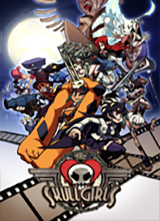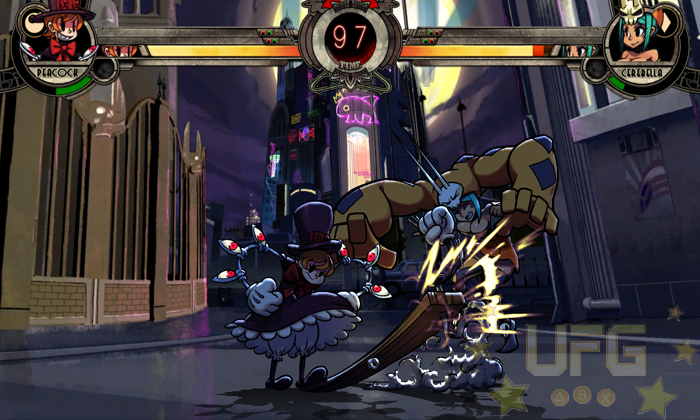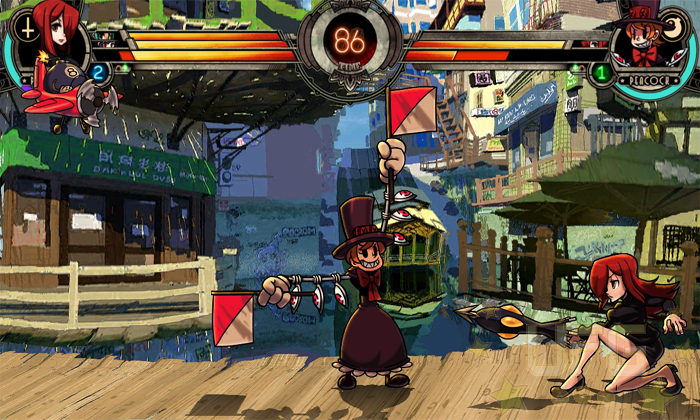Skullgirls
Skullgirls was a game that raised a lot of questions. It’s only a brand new title with all original characters trying to compete in the well-established fighter genre. Most would think “can this new title really compete with giants such as Street Fighter and Mortal Kombat?” The answer is…not entirely!
Skullgirls (SG) is a fun game even though it seems to be aimed only at the hardcore crowd. The game was co-created by a big name from the competitive fighting game community, Mike “Mike Z.” Zaimont. It makes sense for SG to be for the hardcore fighting fans; having a tournament champ as the project lead made sure of that. Before I get into how it caters to the hardcore let me fill you in on some of its basic mechanics. SG allows you to fight it out with a team of 1, 2 or 3 characters. There does not have to be an equal number of characters on each team; you can have a 1vs3, 2vs2, 2vs3 ect. The game manages to keep balance even with mismatched teams. A solo character has more health and does more damage but loses the teamwork aspect of the game like calling in assists (where a teammate jumps in to attack your opponent) and tagging out. The game uses a lot of Capcom and SNK features in terms of gameplay with some unique features for balance and creativity. It really gives the game its own feel. SG uses a six button layout with 3 punches and 3 kicks (light, medium, heavy). If I had to pick a game, I’d say it was most similar to the first MVC title.
The game adds a few brand new features to the genre. The infinite prevention system gives combo breakers if it detects the opponent is trying an infinite combo. This keeps the game competitive and frees all of us of one very abusive tactic. Another new feature is the option of choosing a custom action for an assist. You can pick anything for an assist (except supers). If you wanted to you can set your assist as a throw or even a dash. The move is based off of the button combination you input after picking your character before a match. There are so many possible options with the custom assist mechanic. If you don’t feel like creating an assist, you also have the option of picking one of two generic assist for each character. Then, during the match, pressing light punch/kick and medium punch/kick at the same time will call in your first partner (the medium and heavy buttons calls the second partner). Again, you lose this option if you use a one girl team.
Skullgirls does lack in terms of game modes and character selection. There are only 5 game modes (3 of which are a standard) and 8 characters. You have your Arcade mode which matches you up against AI controlled, random generated teams. There is a training mode as well. Unfortunately it lacks some of the more favored features from other fighting games like a record option to letting you set up a situation yourself to properly train against (like making your opponent jump, block, ect). It does show you the attack and character hit boxes, allowing you to see how attacks work. So the training mode leans more toward the advance players based on the options given. Then comes your pretty generic versus mode which lets you battle on or offline with a friend. The two modes that really make this game stand out are the story mode and the tutorial. The story mode gives every character their own individual…well, story. This is where you can really learn about the cast, like why they fight, their personality, how they became the way they are, and more. The tutorial featured in SG is absolutely amazing. It is by far the best tutorial I have ever played. EVER!! The tutorial goes through all the major points of a fighting game. If you have never played a fighting game in your life and you play this tutorial all the way though, you’ll be able to take that knowledge to any fighting game knowing what to look for and what you should be doing. It teaches you everything from the basic movement to the more advance things like how to set up your offense and how to block against cross-ups. Most fighting games will just toss you into the deep end of the pool but this one will make you battle ready!
The online element in SG is subpar at best. The standard versus mode is the only option if you want to play online. What makes this worse is the fact that SG has no lobby system, which could have saved the online mode in this game. A lobby has become the industry standard for just about any game. If you want to play with a group of friends be ready to quit and rejoin other people a lot. Not only that, SG suffers from extremely long loading screens which may cause a casual player to lose interest waiting on matches. On a more positive note, the game does use the renowned GGPO netcode which has been a favorite of the fighting game community for some time now. The main features are the roll back mechanic and a client side input detection. The roll back feature keeps the players in sync with each other; if the game losses sync it will roll back to the last time it was in sync. The client side inputs make the game feel like you’re playing offline by keeping your inputs sharp. Since the game reads the input from your game directly and then sends the data, it can cause the game to go out of sync. That’s where the roll back feature comes in.
SG can hang with the best of them when it comes to graphics and sound. The game uses anime styled animations similar to the Blazblue series but better. SG’s graphics are so sharp and absolutely beautiful; every character and background in this game is hand drawn at high resolution. This may be the best looking fighting game out there. The sound quality is on par with the graphics. The soundtrack is composed by Michiru Yamane (Castlevania: Symphony of the Night). You can only expect great sounding music. SG has upbeat, big band type music that really keeps up with the fast paced action of the game. That said, Skullgirls suffers so much from the lack of game modes, minimal online and playable characters that it just won’t be able to keep the casual player interested. Unless you are really trying to break in to the fighting game genre this game may not be for you.
Gameplay:
7
With the lack of game modes, no lobby system, and long loading screens it really suffers even though the fighting is a blast.
Graphics:
10
Quite possible the best looking fighting game out there and it’s an XBLA/PSN Store title.
Sound:
10
The music fits in perfectly with the pace of the game and with composer Michiru Yamane leading this part of the show, it was bound to be good!
What's New:
10
The infinite prevention system and custom assist are major innovations in the genre. I really don’t think you’ve seen the last of any of these features.
Replay Value:
5
With very few game modes on or offline, no lobbies and no unlockables (expect for a couple of colors) what is there to really encourage you to keep playing?
Final Score:
8.4



